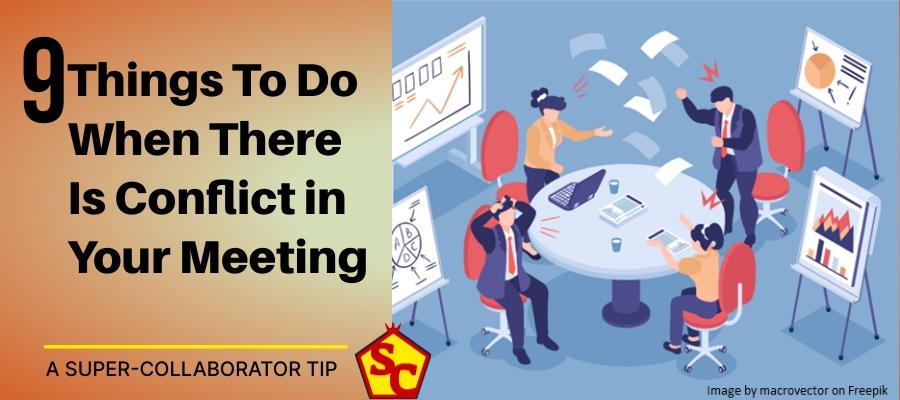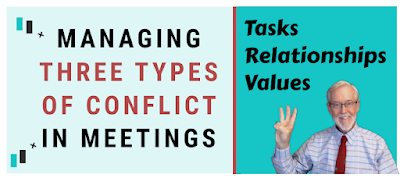9 Things To Do When There Is Conflict in Your Meeting
Conflict can kill progress. And for my students, conflict is one of their biggest worries. Here is what you can do to transform conflict into cooperation in your next meeting.
1. Get your mind in the right frame of mind. I like to reframe the meaning of conflict by asking myself, is this conflict a symptom that the status quo is not working? If there is good faith in the room, then consider asking meeting participants to talk about what is the unmet need that is behind the conflict. Usually, a simple, open-ended question will open this discovery conversation; a question like, “Hold off advocating for a moment. Tell me what is behind your concern. What’s not working now that if resolved could let you agree to the course of action we are talking about in this meeting?”
2. Diagnose first, intervene second. When that discovery conversation gets going, do your best ‘active listening’ to see if you can name the underlying concern. Don’t rush to a solution. Diagnose first by looking for these common sources of the conflict.
- Poor role clarification (who is responsible for what task or what part of a project).
- Poor processes (the right hand is disconnected from the left hand).
- Communication problems (messages are not being heard or respected).
- Lack of performance standards/job expectations (poor clarity or agreement).
- Lack of resources (not enough money, materials, staff, and other assets or too much competition for these resources).
- Unreasonable time constraints (deadlines not stated, confused, or unstable).
- Fear/resistance to change (fear of the unknown).
- Toxic work environment (competition, bullying, distrust, etc.).
- Personality differences (lack of respect and tolerance).
- And more…(that’s why you are actively listening!).
3. Negotiate the terms of the conversation. Often a conflict in a meeting takes a life of its own—organically evolving but in a dysfunctional way. Instill some control. Have the participants negotiate both the way they speak to one another and a mutual commitment to finding a joint (collaborative) solution. Conflict in my meetings is often eased because the group agreed to the rules on how to talk to one another and a peer-to-peer pledge to find a common ground.
4. Adjust the scope of the conversation. Frequently, people talking past one another are doing so because they are having different conversations. Get the group to confirm that they are focused on the right end-point (objectives) and are talking about the correct array of elements needing resolution to get to that end-point. If the group is too zoomed in on a narrow subset of details, too broad, or focused on different subjects take a step back and define the scope of the conversation.
5. Develop empathy. “I want…” comments are common in a conflict conversation, although they are usually stated in more diplomatic terms. Behind ‘wants’ are, usually, unmet needs. Build positive relationships between adversaries by getting them to better understand where each other is coming from and what they’re trying to achieve. Armed with a deeper understanding people are more likely to be empathetic to one another. Do that with a conversation about needs not wants.
6. Say back what you heard. Counterparts may be bickering because they are listening only to decide what they want to say next instead of listening to understand one another. I am routinely successful when I interject a facilitator’s request that the parties with the conflict summarize by repeating back what they heard each other say. This is a great way to respectfully force active listening. It does put people on the spot. So, you have to use facilitator diplomacy. But it does improve listening. I usually introduce this facilitator’s request with a phrasing that says I am seeking communication clarity, not criticizing. A phrasing that works for me is something like, “To make sure we are clear about what’s going on for everybody, I am going to ask you to summarize what the other person is saying. John, would you go first? What do you hear Jane saying? ” Then turn to Jane to summarize what she heard John say.
7. Change the conditions and negotiate the process. Whether it’s the location of the conversation or the rules that are brought to the table, conditions matter. Shape the environment of the conversation for success with a seating arrangement that equalizes power and provides safety for a difficult conversation. And establish an expectation that the purpose of the conversation is to co-create a workable solution for everyone, not win. In other words, set up a power balance and a shared responsibility for collaboration and compromise.
8. Establish the right decision-making standard; use ‘Good Enough for Now, Safe Enough to Try.’ People in conflict have an instinct to seek a perfect solution—for themselves, not the other party. But people who are about ready to take a risk and try something new to end their conflict need safety at the same time. If you, as the facilitator, are silent about what decision standard to use in crafting a collaborative solution, everyone will define it differently for themselves. Facilitate a conversation to encourage a ‘Good Enough for Now, Safe Enough to Try’ standard for the meeting.
9. Require that the parties make offers. Most conflicts I encounter in meetings involve people sparing over competing ideas. The debate quickly moves to each side trying to either prove the other is wrong or that their idea is superior. Create a pathway out of this blocking behavior by asking the parties, one at a time, to make an offer to resolve the issue in a way that will meet everyone’s needs. And here is where Tip Number 8 kicks in. The offers do not have to be perfect. Enforce the ‘Good Enough’ standard. The best question I use to ask for these offers is, “What do you most want to see happen that will work for you and everyone else at the same time that is good enough for now?”
- - - - -
Conflict is not something to avoid at all costs. Conflict can be the quickest and best way to make creative progress because it does not ignore the issue hoping it will go away. You certainly don't want everyone automatically saying, "Yes" to everything without proper discussion because that is the way to expose problems with the status quo! Facilitating conflict starts with your next meeting. Use these steps to navigate and, in so doing, make one of the most valuable contributions a facilitator can make to help teams succeed.
____________
© 2024, Michael E. Fraidenburg. All rights reserved.



